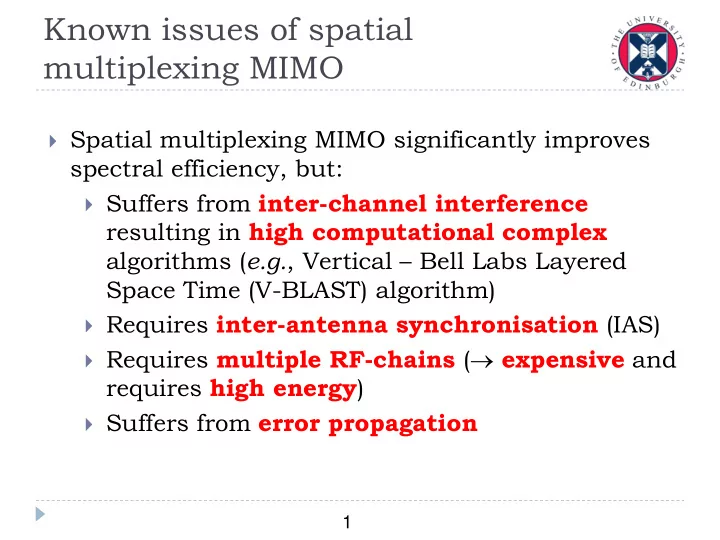

Known issues of spatial multiplexing MIMO Spatial multiplexing MIMO significantly improves spectral efficiency, but: Suffers from inter-channel interference resulting in high computational complex algorithms ( e.g. , Vertical – Bell Labs Layered Space Time (V-BLAST) algorithm) Requires inter-antenna synchronisation (IAS) Requires multiple RF-chains ( expensive and requires high energy ) Suffers from error propagation 1
Spatial Modulation: How does it work? Im Signal Constellation B(A) Im C(A) A(A) D(A) A (Tx1) Re Im B (Tx2) Re B(D) C (Tx3) C(D) A(D) D(D) D (Tx4) Re Spatial Constellation 2
SM Principle Im C B D A B C Signal Constellation Diagram Spatial Signal Spatial Signal Spatial Signal symbol symbol symbol symbol symbol symbol t 1 t 3 t 2 A (Tx1) Re Im B (Tx2) B(C) C (Tx3) t 1 C(C) A(C) D(C) D (Tx4) Re Spatial Constellation 3
SM Principle Im C B D A B C Signal Constellation Diagram Spatial Signal Spatial Signal Spatial Signal symbol symbol symbol symbol symbol symbol t 1 t 3 t 2 A (Tx1) Re Im B (Tx2) C (Tx3) B(D) Re t 2 D (Tx4) C(D) A(D) D(D) Spatial Constellation 4
SM Principle Im C B D A B C Signal Constellation Diagram Spatial Signal Spatial Signal Spatial Signal symbol symbol symbol symbol symbol symbol t 1 t 3 t 2 A (Tx1) Re B(B) Im t 3 B (Tx2) C(B) A(B) D(B) C (Tx3) D (Tx4) Re Spatial Constellation 5
SM Complexity vs. Performance Data Rate Complexity 6
Key Advantages of SM SM entirely avoids inter – channel interference (ICI) and requires no synchronisation between the transmit antennas. No constraints on the number of receive antennas or transmit antennas. Achieves spatial multiplexing gains even for a single receive antenna. Only a single RF chain is required at the transmitter. Better robustness to channel estimation errors compared to V-BLAST. Better robustness to channel correlation compared to V- BLAST. Has been shown to outperform V-BLAST in terms of ABER. The computational complexity is independent of the number of transmit antennas. 7
Recommend
More recommend